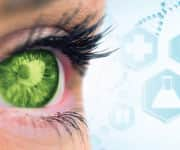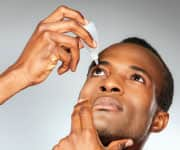http://articles.mercola.com/sites/articles/archive/2009/08/20/prostate-cancer-treatment-choices.aspx
If you've been diagnosed with prostate cancer, your doctor probably ran down a list of confusing treatment options and told you to pick your poison (make a choice among options).
The simplest option when you've been diagnosed with prostate cancer is known as watchful waiting, which means doing nothing unless later tests show the cancer is worsening.
More aggressive options include removing your prostate gland or receiving one of several forms of radiation. The latest treatment, called proton radiation therapy, can run $100,000 and involves a proton accelerator that can be as big as a football field.
Unfortunately for the developers and investors, very few people will be able to afford that option with a cataclysmic economic collapse in the making.
One in Six Men in the U.S. Gets Prostate Cancer
Prostate cancer kills an estimated 35,000 men in the United States each year and attacks another 165,000.Experts Can't Agree on the Effectiveness of Traditional Cancer Treatments
Most cases of prostate cancer do not occur until after men turn 50, but in recent years there has been a steady rise in the percentage of men in their 30s and 40s with both prostate problems and prostate cancer, primarily as a result of poor diet and increasing environmental pollution. One man in six will get prostate cancer during his lifetime.
The New York Times reported that, "Some doctors swear by one treatment, others by another. But no one really knows which is best. Rigorous research has been scant. Above all, no serious study has found that the high-technology treatments do better at keeping men healthy and alive. Most die of something else before prostate cancer becomes a problem."[1]The PSA Test for Prostate Cancer is Deceptive
"No therapy has been shown superior to another," an analysis by the RAND Corporation found.
Dr. Michael Rawlins, the chairman of a British medical research institute, said "We're not sure how good any of these treatments are."
Dr. Daniella Perlroth, a board-certified internist and infectious disease specialist at Stanford University, was asked what she would recommend to a family member. Perlroth paused, then said, "Watchful waiting."
- Watchful waiting costs a few thousand dollars in doctor visits and tests. Actually, watching and waiting means doing nothing when there are plenty of wonderful and natural things one can do to improve PSA scores. (Note below that PSA scores do not offer the best guidance.)
- Surgery to remove the prostate gland costs about $23,000; possible complications include impotence and urinary incontinence.
- A targeted form of radiation known as Intensity Modulated Radiation Therapy (IMRT), runs $50,000. IMRT involves a large time commitment, requiring patients to visit a radiation center 45 times over the course of nine weeks. A concern is the multiple-beam radiation of IMRT may raise the risk of secondary cancers since science already knows radiation exposure causes cancer.
A report published in the June 2009 issue of A Cancer Journal for Clinicians shows routine PSA blood tests often result in over diagnosis of prostate cancer, resulting in unnecessary treatments.A Saner, Safer Approach to Treating Prostate Cancer
There are over one million prostate cancer tissue biopsy procedures performed annually in the U.S. Approximately 25 percent of these tissue biopsies are reported "positive," indicating the presence of prostate cancer. The remaining 75 percent are reported "negative."
One-third of the men with initial prostate tissue biopsies that are reported as "negative" for prostate cancer actually do have prostate cancer that was missed by the biopsy.
Drs. Boyle and Brawley of the International Prevention Research Institute, Lyon, France said, "The real impact and tragedy of prostate cancer screening is the doubling of the lifetime risk of a diagnosis of prostate cancer with little if any decrease in the risk of dying from this disease."[2]
"The PSA era is over in the United States," says Dr. Thomas Stamey, professor of urology and lead author of a study published in the Journal of Urology. "Our study raises a very serious question of whether a man should even use the PSA test for prostate cancer screening any more. From the time it first became standard to remove prostates in response to high PSA levels to the present - reveals that as a screen, the test now indicates nothing more than the size of the prostate gland." [3]
According to the American Cancer Society, "There can be different reasons for an elevated PSA level, including prostate cancer, benign prostate enlargement, inflammation, infection, age, and race," all factors that make PSA test results confusing, leading to potential for unnecessary treatment and suffering when tests are elevated.
Complications of ill advised prostate cancer treatments include urinary incontinence and erectile dysfunction. Both of these conditions are difficult to reverse and can significantly decrease your quality of life.
The New York Times article did not mention the option of doing what makes sense while you watch and wait, and it is hard to understand why.Iodine and Cancer
There are natural nutritional agents that can help you prevent and treat prostate cancer, including getting lots of sun exposure to drive up your vitamin D levels. This approach costs virtually nothing.
A study conducted at the University of Illinois has found an interesting relationship between prostate cancer and daily consumption of broccoli and tomatoes. Both these vegetables have been known to contain compounds that can fight cancer. These compounds seem to work better in combination.
Iodine is also a key component because reduced iodine levels in the breasts, ovaries, thyroid and prostate glands predispose you to higher cancer risk.
Supersaturated potassium iodide works well. Typically one to three drops per drops.Selenium Can Protect Your Prostate
Though it costs a bit more, Nascent Iodine is more palatable (less caustic) for oral usage and is the preferred treatment for children.
Even at maximum dosage, we are talking about treatment costs of approximately $70 a month. This means you can do iodine for more than a thousand months before you spend what you would to have protons warped into your gland.
This is a treatment you should consider, as is sodium bicarbonate, which we will talk about in depth below.
A 1996 study by Dr. Larry Clark of the University of Arizona showed just how effective selenium can be in protecting against cancer.Decrease Calcium, Increase Magnesium to Reduce Your Prostate Cancer Risk
In the study of 1,300 older people, the occurrence of cancer among those who took 200 micrograms of selenium daily for about seven years was reduced by 42 percent compared to those given a placebo.
Cancer deaths for those taking the selenium were cut almost in half, according to the study, which was published in the Journal of the American Medical Association on December 25, 1996.
In addition, the men who took selenium had 63 percent fewer prostate cancers, 58 percent fewer colorectal cancers, 46 percent fewer lung cancers and overall 37 percent fewer cancers.
Selenium was found to reduce the risk of lung cancer to a greater degree than stopping smoking. [4]
Calcium and magnesium are opposites in their effects on your body structure. As a general rule, the more rigid and inflexible your body structure, the less calcium and the more magnesium you need.Inexpensive, Revolutionary Treatments for Cancer
"There is reasonable evidence to suggest that calcium may play an important role in the development of prostate cancer," says Dr. Carmen Rodriguez, senior epidemiologist in the epidemiology and surveillance research department of the American Cancer Society (ACS).
Rodriguez cites a 1998 Harvard School of Public Health study of 47,781 men that found those consuming between 1,500 and 1,999 mg of calcium per day had about double the risk of being diagnosed with metastatic prostate cancer (cancer that has spread to other parts of the body) as those getting 500 mg per day or less. Men taking in 2,000 mg or more had over four times the risk of developing metastatic prostate cancer as those taking in less than 500 mg.
Another Harvard study conducted in October 2001 looked at dairy product intake among 20,885 men. Researchers found men consuming the most dairy products had about 32 percent higher risk of developing prostate cancer than those consuming the least.
High calcium levels interfere with Vitamin D and subsequently inhibit the vitamin's cancer protective effect unless extra amounts of Vitamin D are supplemented.[5]
High magnesium chloride intake, known as magnesium oil, can reverse calcification damages and inflammation when used intensely.
The remainder of this article will be a discussion of two ground-breaking treatments for cancer at the opposite end of the spectrum from high-tech, expensive proton therapy:Do You Know your pH Level?
These two therapies, with a full spectrum natural chemo protocol behind them, are cost effective for individuals and society, and by all indications are also effective and safe.
- Sodium bicarbonate therapy, which is a kind of natural chemotherapy that can be done easily and safely by anyone for less than $5.00
- Prostate massage, which can be self administered for free or done by medical doctors.
Even if you are considering or undergoing more traditional cancer treatments, both sodium bicarbonate and prostate massage should be adjunct therapies. They can reduce and buffer the toxicity and harm of aggressive chemical and radiation treatments, and improve your overall results.
Actually, both of these treatments and all the concentrated nutritional medicinals discussed earlier offer you nothing to lose and everything to gain in your fight against prostate cancer.
Studies have shown how manipulation of tumor pH with sodium bicarbonate enhances chemotherapy.[6]Destroying Tumors with Sodium Bicarbonate
If your pancreas is healthy, it secretes sodium bicarbonate to neutralize stomach acid and create an optimal pH environment for pancreatic enzymes. Some of these enzymes circulate in your blood to destroy cancers that occur. Too much iron interferes with the ability of your pancreas to generate sodium bicarbonate and can lead to insulin resistance. Diabetes and cancer are linked because an unhealthy pancreas advances both diseases.
What is not generally understood is how basic to health your pH and bicarbonate levels are and how easily you can become acidic, which is an open invitation to cancer.
Cancer is actually a four-letter word, acid, especially lactic acid as a waste product due to the low oxygen level and waste products of yeast and fungus.
Cancer cells look like yeast and fungi, and many of them are. Even mainstream oncology practitioners admit it. But whatever the definition and concept of cancer, it does not change the fact that cancer does not like what bicarbonate brings to your body.
You might be surprised to learn there is an oncologist in Rome Italy, Dr. Tullio Simoncini, destroying cancer tumors with sodium bicarbonate.Oral and Transdermal (Through the Skin) Dosing
Sodium bicarbonate is safe, extremely inexpensive and unstoppably effective when it comes to cancer tissues. It's an irresistible chemical, cyanide to cancer cells, for it hits the cancer cells with a shock wave of alkalinity, which allows much more oxygen into the cancer cells than they can tolerate. Cancer cells cannot survive in the presence of high levels of oxygen.
Sodium bicarbonate is, for all intent and purposes, a killer of tumors. At a pH slightly above 7.4, cancer cells become dormant. At pH 8.5, cancer cells will die while healthy cells will live.
Sodium bicarbonate possesses the property of absorbing heavy metals, dioxins and furans. A comparison of cancer tissue with healthy tissue from the same person shows the cancer tissue has a much higher concentration of toxic chemicals and pesticides.
This has given rise to a variety of treatments based on increasing the alkalinity of the tissues, such as vegetarian diets, consuming fresh fruit and vegetable juices, and dietary supplementation with alkaline minerals such as calcium, potassium, magnesium, cesium and rubidium. But nothing can compare to the instant alkalinizing and oxygenating power of sodium bicarbonate for safe and effective treatment of cancer.
Transdermal iodine therapy can be traced all the way back to the American Civil War when iodine was used as a universal medicine. However, most practitioners are new to natural transdermal medicine and how its power and safety can be brought to bear on glands like the prostate.Cancer and Fungus
Treating prostate cancer demands we systemically take pH up over 8. This can be done orally and the improved pH level will register in all the tissues of your body.
We can also put a high concentration of bicarbonate in an enema and combat not only intestinal cancer and strong yeast overgrowth, but the prostate area as well.
Iodine can also be applied directly to the prostate tissue areas transdermally using a long swab, or applying it liberally to genital areas and the perineal region as an adjunct to oral dosing.
Dr. Simoncini uses bicarbonate targeted more directly to the prostate thru the artery providing its blood supply.
Tumors are not distinguishable from the infections that inhabit them. Naturopath Dr. Marijah McCain identified the primary cause of death in cancer patients to be not the cancer itself, but fungal overgrowth.An Active Sex Life is Good for Your Prostate
Dr. Simoncini says, "At the moment, against fungi there is no useful remedy other than, in my opinion, sodium bicarbonate."
Bicarbonate is a chemo agent and in fact is used in oncology with its horrid list of chemo agents, but it is used to buffer the effects of the dangerous chemo chemicals. Traditional chemo is just much too dangerous to undergo without sodium bicarbonate, meaning the side effects would escalate beyond acceptable limits if not used. In fact, so dangerous and toxic are most chemo chemicals that many people would die on the spot without softening the blow with bicarbonate.
There's no need to fear bicarbonate intake. In fact, people who live in areas of the world with high amounts of bicarbonate in their drinking water have a strikingly decreased mortality rate and a decreased prevalence of disease.
Sodium bicarbonate, though often used as a medicine, is unlike pharmaceutical compounds. It is a natural non-toxic substance that does not require clinical trials for an assessment of toxicity. Spring waters contain bicarbonate ions which are coupled mainly with sodium, potassium, calcium or magnesium ions. A deficiency of bicarbonate ions in your body contributes to a range of diseases and medical conditions.
Research has shown sexual activity and a high ejaculation frequency are linked to a lower risk of prostate cancer later in life.Prostate Massage
An epidemiological study of 30,000 men showed that men who ejaculated 13 to 20 times monthly presented a 14 percent lower risk of prostate cancer than men who ejaculated on average, between four and seven times monthly during most of their adult life. Those ejaculating over 21 times a month presented a 33 percent decreased risk of developing prostate cancer than those on the baseline.
Orgasm acts as a powerful pain-relief agent, and studies suggest it bolsters your immune function. The typical orgasm will boost your body's T3 and T4 lymphocyte cells -- the cells that fight off foreign invaders -- by up to 20 percent.
Michael Leitzman, a cancer researcher at the National Cancer Institute in Bethesda, Maryland, and author of the above mentioned study, explains there has been a suggested connection between greater sexual activity and increased incidents of prostate cancer in previous scientific data because of the link with the male hormone testosterone and its effect on promoting cancer cell growth.
But Leitzman says this theory has its shortcomings because testosterone levels alone do not predict prostate cancer risk, and they do not appear to correlate with sexual desire as much as previously thought.
Instead, researchers say ejaculation may protect your prostate through a variety of biological mechanisms that merit further research, such as:
- Flushing out cancer-causing substances. Frequent ejaculation may help flush out retained chemical carcinogens in your prostate glands.
- Reducing tension. The release of psychological tension that accompanies ejaculation may lower nervous activity associated with stress and slow the growth of potentially cancerous cells in your prostate.
- Promoting rapid turnover of fluids. Frequent ejaculation may help prevent the development of mini-crystals that can block ducts within your prostate gland, reducing your cancer risk.
As men age, an enlarging prostate is a common problem. Fat and proteins can accumulate and expand your prostate gland to the point of pain and recurrent urinary problems.Improve Blood Flow for a Healthy Prostate
A prostate massage (also known as prostate milking) is a good way to drain the prostate. Even if you do not have any concerns with your prostate yet, it is recommended you do a massage once a month to prevent problems later.
If you already have prostate problems, a daily massage in addition to the medicinal therapies discussed above may be needed to reduce pain and swelling.
"Part of the role of the prostate gland is to produce a clear fluid which makes up about 30 percent of male seminal fluid and, in cases of chronic prostatitis or benign prostatic hyperplasia, prostate milking can be used to reduce pressure in the prostate gland by removing excess fluid. Although it is possible to perform prostate milking externally by stimulating the prostate through the perineum this method is not always successful and it is more usual for prostate milking to be performed internally using a finger, prostate massager or a medical massager," writes author Donald Saunders.[7]
Prostate massage is part of the digital rectal examination (DRE) routinely performed on male patients by urologists in order to look for nodules of prostate cancer and to obtain expressed prostatic secretions (EPS) for examination under a microscope. Many doctors instruct patients to do this in order to keep the prostate healthy.
If you have an enlarged prostate, massage brings fresh blood and oxygen to the normally congested and suffocating prostate gland.Address Your Emotions for Optimal Health
Viruses, bacteria and fungus are waiting for the right conditions in which to begin rapid multiplication. Infection is a natural process of biological decay, which congestion and blood stagnation encourages.
Fresh healthy blood is healing to tissues and milking the prostate gland also keeps sexual fluids (semen) fresh, clean, and moving out of your body. When fluids stagnate or blood and oxygen flows diminish, disease thrives. In cases of chronic prostatitis (an inflammation of the prostate gland) or an enlarged prostate (benign prostatic hyperplasia, or BPH) prostate milking can be helpful in reducing pressure in the prostate gland by removing excess fluid.
If you're concerned about the health of your prostate, you should do a prostate massage at least once a month.
A word of caution: If you are suffering from as yet undiagnosed prostate cancer, massage could result in cancer cell clusters breaking apart and spreading the cancer within your prostate gland and even to other areas of your body.
If you are diagnosed with prostate cancer, the prostate massage can be an important part of your treatment, but it is essential to target the cancer with bicarbonate, iodine, magnesium chloride and selenium before you start a massage routine. The idea is to completely change the condition not only inside and around the prostate gland but systemically as well, so further cancer growth is not encouraged or allowed.
Researchers have found the average victim of breast or prostate cancer was unable to express such basic drives as anger, aggressiveness, or sexual impulses.Conclusion
In Psychosomatic Medicine, California's Dr. Eugene M. Blumberg and his colleagues report on patients with a wide variety of cancers: "We were impressed by the polite, apologetic, almost painful acquiescence of the patients with rapidly progressing disease, as contrasted with the more expressive and sometimes bizarre personalities of those who responded brilliantly to therapy with long remissions and long survival."
One in three breast cancer patients today may be treated unnecessarily and thus incorrectly according to a 2009 study.[8]
We can infer, without such a study for prostate patients, the story would be uniformly the same for them. Cancer sufferers en mass are being forced to pay with their lives for the incredible arrogance of oncologists and medical officials who refuse to open their eyes to see the medically sound solutions already out there.
There are many ways to treat cancer and new ideas are constantly being presented and then ignored. Examples:
It is shocking how many people die from cancer even after governments have thrown the kitchen sink at it. After hundreds of billions spent on research, people are still dropping dead at close to the same rates as years past but no one thinks that the medical establishment is at fault.
- A study published in the European medical journal Anticancer Research demonstrates a substance used as a cough suppressant for over 50 years may be useful in treating advanced prostate cancer.
- Researchers from the Prostate Cancer Research and Educational Foundation, the MedInsight Research Institute, and the University of California in San Diego found that noscapine, a non-addictive derivative of opium, reduced tumor growth in mice by 60 percent. What's more, it halted the spread of tumors by 65 percent and caused no harmful side effects.
- Medical marijuana, especially when taken in the form of oil, is also known to arrest cancer.
- Spices add flavor to food but also may have cancer-fighting properties. India has one of the lowest cancer rates in the world, and the people there typically eat a diet containing a wide variety of spices. There is some limited evidence that capsaicin, the component of chili peppers that makes them hot, has some anti-cancerous properties. Both curry and cumin contain turmeric, which has been found to have anti-carcinogenic properties in cell cultures.[9] In studies involving mice, curcumin has demonstrated anti-carcinogenic activity in a variety of cancers.[10] A compound in aged garlic significantly inhibited the growth of human prostate cancer cells in vitro.[11]
- Part of any successful cancer treatment includes chelation and detoxification of heavy metals and a host of toxic chemicals, which are all invading your body every day.
Every man should have all this information in his hands and every woman who has a man she loves should have it as well.
With the guidance of an enlightened healthcare practitioner or doctor, and with the right protocol and multidimensional treatment approach, there is really no reason why a man has to die of prostate cancer or subject himself to harmful radiation or surgery. The same goes for women and breast cancer.
[1] The New York Times, In Health Reform, a Cancer Offers an Acid Test, July 7, 2009 http://www.nytimes.com/2009/07/08/business/economy/08leonhardt.html
[2] www.examiner.com/x-14041-Charlotte-Health-and-Happiness-Examiner~y2009m6d29-Prostate-cancer-test-value-not-proven-says-report and www.cancer.gov/cancertopics/factsheet/detection/PSA
[3] www.medicinenet.com/script/main/art.asp?articlekey=39078
[4] Clark LC. The epidemiology of selenium and cancer. Fed Proc 1985; 44:2584-2590.
[5] Accu-Cell Nutrition; Calcium and Magnesium www.acu-cell.com/acn.html
[6] Enhancement of chemotherapy by manipulation of tumour pH. Raghunand N, He X, van Sluis R, Mahoney B, Baggett B, Taylor CW, Paine-Murrieta G, Roe D, Bhujwalla ZM, Gillies RJ. Arizona Cancer Center.
[7] ezinearticles.com/?The-Ins-And-Outs-Of-Prostate-Milking-Or-Prostate-Massage&id=640873
[8] Karsten Jorgensen and Peter Gotzsche of the Nordic Cochrane Centre in Copenhagen analyzed breast cancer trends at least seven years before and after government-run screening programs for breast cancer started in parts of Australia, Britain, Canada, Norway and Sweden. The research was published in July of 2009 in the BMJ, formerly known as the British Medical Journal.
[9] Rao CV, et al. Chemoprevention of colon carcinogenesis by dietary curcumin, a naturally occurring plant phenolic compound. Cancer Res 1995; 55: 259-66.
[10] Huang MT, Newmark HL, Frenkel K. Inhibitory effects of curcumin on tumorigenesis
in mice. J Cell Biochem Suppl 1997; 27: 26-34.
[11] Raloff J et al. Radical prostates. Science News 1997 151: 126-27.






